Thanks to Scot Kinbaku who said that since I keep referring to "soma" during our workshops, I should explain it, so here it comes :) If it gets too nerdy, there is a TLDR version at the end! ;)
There is a quote from Thomas Hanna displayed on my computer screen for years that is full of magic for me. It says: “A soma is any individual embodiment of a process, which endures and adapts through time, and it remains a soma as long as it lives. The moment that it dies it ceases to be a soma and becomes a body”.
Soma is not a thing, it’s a process.
It shows up in movement: enjoying or worrying, making out and making a conflict, being scared or shy, giving and receiving, playing, sweating, expanding and contracting, fidgeting, escalating and calming down… in other words, showing up as a living being.
This movement is always there, for as long as you live… I feel very sentimental writing about that and I notice my eyes become wet. I feel like a mystery of life shines through this process. Is it just me?..
Soma is life experienced from within by first-person perception.
That is, we are (or, we can be: it’s a possibility) self-aware. The two different points of view are available to us as human beings: we are equally capable of being internally self-aware as well as externally self-aware. We are not always aware of this possibility, and we often remain stuck in the third-person mode of observation, even when it is directed at ourselves as if we were deliberately objectifying ourselves and stripping ourselves of our humanity…
Sadly it is typical for the way we do psychology and medicine and science in general. Internal proprioception is an impediment in our society that teaches us to objectify ourselves on a large scale. Feeling ourselves internally – what is essentially about experiencing your life in your own skin – is becoming more and more of an outdated, obsolete feature. Quite the opposite of what Thomas Hanna had hoped for in the 70s…
Soma is self-sensing and self-regulating.
The human is not only a self-aware soma, but it is doing something else constantly: it is acting upon itself, meaning, it is always engaged in the process of self-regulation. Most intelligently, it will use all available resources, to adapt to any new environment, to endure and to survive.
Maybe you noticed that when in ropes, you are put in a new uncomfortable position, your body starts working, adapting to the tie: adjusting movement, adjusting breathing… That all will happen without you being consciously involved or making any conscious decisions (where is your attention?) Sometimes letting your soma “take care of it” is the best way to handle the situation. It requires a great deal of self-trust, of course…
Underneath all that there is a fundamental need to preserve, to survive. Somas always choose life. How fascinating and life-affirming is that?
I want to finish with another quote from Thomas Hanna. “Soma,” he wrote in his book “Bodies in Revolt”, means “Me, the bodily being”; “somas are you and I, always wanting life and wanting it more abundantly”.
